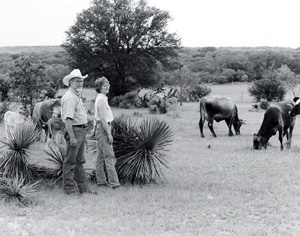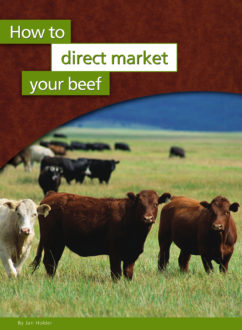
Written by Dan, Peggy & Richard Sechrist
What follows are some of the nitty-gritty details you need to consider in your profit equation. While you probably want to consider these options before launching a direct-marketing strategy, there is always opportunity to revisit these costs at any stage of the game.
Production costs. If you want to truly calculate your profit margin when direct marketing beef, you must include the full cost of production. You may even want to treat production costs as a separate “business” in your bookkeeping. Production costs are the total cost of the raw material needed to create your packaged product. It is essential to know if your gross profit covers the replacement value for the animals you are selling.
Processing costs. Processing costs for individual beef producers can vary a great deal and can take a big chunk out of your bottom line. The easiest way to compute and monitor processing costs is to calculate per head. The difference between your total cost and the total price you receive from the sale of each animal is your profit margin. The retail market price of beef is heavily influenced by the large beef packers who process several thousand head of cattle per day in their own facilities. This volume gives them a competitive edge by lowering their processing costs per head, and allowing them to set a low market price on beef. By contrast, individual beef producers may pay as much as 800 to 900 percent higher costs for processing and still need to price their beef within a competitive range. So managing your processing costs is very critical to your bottom line.
Market requirements. Who you are processing for is a related cost that requires careful management. When you decide to market your own beef, you may sell to three different markets:
- Distributors, who re-sell your beef to retailers
- Wholesale markets, such as retail food stores and restaurants
- Direct to consumers
The sales price structure for each of these segments is different. You receive the highest price when you sell direct to consumers. You receive a lower price for wholesale, and lower still for distributors. The requirements for how you cut and package your beef may differ among these market segments, too.
For example, the distributor may want each steak and roast “portion cut,” meaning that each cut weighs exactly the same. Portion cutting adds additional cost to your processing fees while generating the lowest price. Wholesale customers may also make special requests that add to your costs. Selling direct to consumers may require you to use a USDA-approved label. You will need to discuss this with the licensed inspector at your processing plant. All these marketing options directly impact your profit margin. It pays to research and analyze your markets before you spend much money on your processing.
Carcass yields. It’s important to calculate the percentage of each animal that returns to you as saleable beef after processing. That percentage can either help you achieve your desired profit margin – or wipe it out completely. There are industry averages, but there is so much variance that it behooves a producer who direct markets his own meat to calculate – in pounds – how much beef is available to sell after processing, then calculate what that available beef will return to see if the resulting profit margin is acceptable. Each animal is a bit unique in its capacity to finish.
Collecting data from each animal as it is processed – or averaging each group of animals processed – is vital to determine which slaughter weight leads to the highest yield of meat to sell.
Your yield from live weight to boxed beef is the yield you want to track. If you process 100 animals, all at 1,000 pounds live weight, your yield could vary more than you realize if you don’t collect that data. If your yield of meat drops by as little as 3 to 5 percent, you can lose a large portion or even all of your profit. For example, a 5-percent yield deviation on 100 animals processed at 1,000 pounds live weight could reduce your profit margin by $20,000. Tracking this information as it occurs gives you a window of opportunity to strategize how to regain some profit before your product is sold.
Storage and obsolescence risk. There is substantial risk to creating a high number of different cuts to satisfy all the requests you may receive. You could butcher a carcass into 20 or more different cuts in pursuit of different customers. Yet, unless you have a guaranteed commitment for a special cut, you could easily find yourself with a stockpile of those cuts in frozen storage. The revenue that these cuts represent, along with their storage costs, could easily wipe out your profit margin.
A similar risk is to discount cuts that accumulate in storage. Discounting also will reduce your profit. Eight to nine of the most popular cuts give you the greatest flexibility to sell the whole carcass within a reasonable period of time.
Management skills. Managing the sale of several beef cuts as opposed to selling a live animal requires different management methods. You’ll find it important to know exactly what your total cost is in each animal as well as knowing exactly what your gross profit is for each animal. Because small deviation in yields or accumulation of a few cuts can so dramatically impact your bottom line, you will want to track your return on each animal and be poised to make adjustments before you find yourself somewhere in the red.
